You’re facing a choice between two smart thermostats, and the installation process shouldn’t be your biggest concern. While both Ecobee and Nest offer impressive features, Ecobee’s design philosophy fundamentally differs in how it handles power requirements and room-by-room temperature control. The real question isn’t whether you can install either device yourself—it’s understanding which one will actually work better in your specific home setup and why that matters more than you might think.
Understanding the Key Differences Between Ecobee and Nest
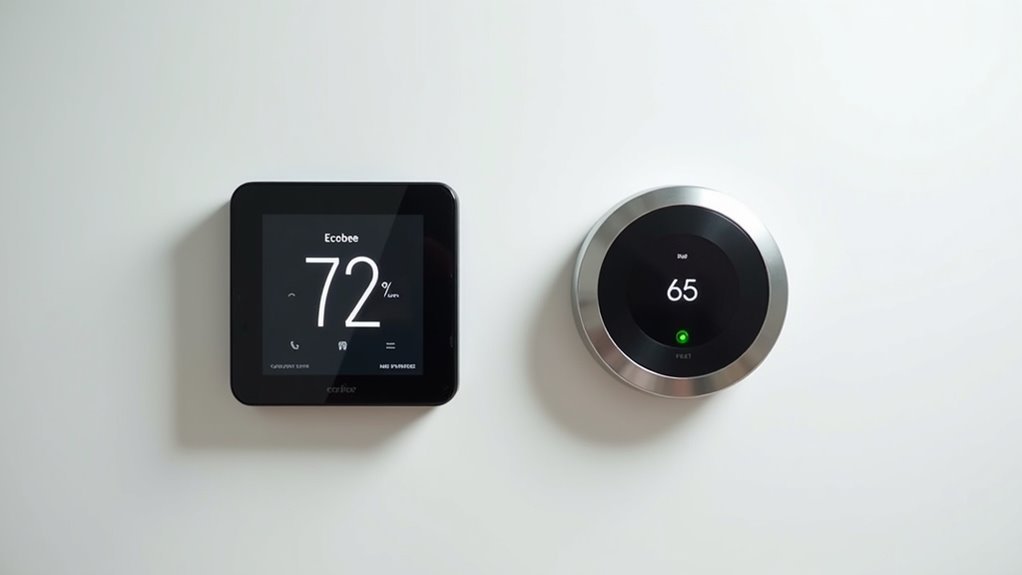
When choosing between these two leading smart thermostat brands, you’ll encounter several fundamental differences that can considerably impact your home’s comfort and energy efficiency.
Ecobee stands out with its touchscreen display and extensive Power Extender Kit, eliminating C wire complications that plague many Nest thermostat installations. You’ll achieve superior energy savings with Ecobee, reaching up to 26% compared to Nest’s 10-15% reduction.
Ecobee delivers superior energy savings of up to 26% while eliminating installation headaches with its comprehensive Power Extender Kit.
Ecobee’s remote sensors come standard, providing precise temperature control across multiple rooms, while Nest limits this feature to premium models.
For smart home integrations, you’ll enjoy broader compatibility with Ecobee, including Apple HomeKit support, whereas Nest primarily works with Google Home, restricting your ecosystem choices and limiting seamless automation possibilities.
Power Requirements: Why Ecobee’s 24 VAC Connection Matters
While Nest thermostats often struggle with power-related installation challenges, Ecobee’s 24 VAC connection requirement guarantees you’ll enjoy consistent, reliable operation from day one.
Unlike battery-dependent models, your Ecobee won’t experience power interruptions that compromise performance.
The C wire connection guarantees stable power flow, enabling advanced features like real-time monitoring and remote control without disruption.
You’ll benefit from superior energy management capabilities that optimize your HVAC system’s efficiency automatically.
This direct power approach delivers accurate temperature readings consistently, while battery-operated alternatives may suffer from power-related fluctuations.
Professional installation becomes worthwhile when you consider how proper wiring eliminates common smart thermostat issues.
Your investment in reliable 24 VAC connection infrastructure pays dividends through enhanced functionality and dependable long-term operation.
Installation Complexity: Ecobee Vs Nest Setup Process

Although both Ecobee and Nest promise straightforward installation, the reality depends heavily on your home’s existing wiring configuration.
Your home’s existing wiring determines whether that promised straightforward installation becomes reality or requires professional intervention.
Nest’s installation complexity remains minimal due to its lithium-ion battery, eliminating C wire requirements that plague older homes with simpler wiring systems. You’ll follow on-screen instructions for a quick setup process.
Ecobee’s installation process proves more demanding, typically requiring four-wire setups for reliable operation. Without proper wiring, you’ll need Ecobee’s Power Extender Kit, adding complexity and time.
The integration of remote sensors further complicates installation compared to Nest’s streamlined approach.
If you lack HVAC experience, Ecobee may necessitate professional assistance to prevent battery drainage issues, while Nest’s user-friendly design accommodates DIY installation regardless of your technical background.
Remote Sensors and Temperature Accuracy Advantages
Since temperature variations across different rooms can greatly impact your comfort and energy bills, Ecobee’s remote sensor system delivers a clear advantage over Nest’s single-point monitoring approach.
You’ll get precise temperature accuracy through sensors covering up to 1,000 square feet each, ensuring your thermostat responds to actual room conditions rather than hallway readings.
Ecobee’s remote sensors include motion detection, so your system prioritizes heating and cooling in occupied spaces.
You can customize temperature preferences for different rooms, maximizing both comfort and energy efficiency. This targeted approach helps you avoid wasting energy on empty rooms while maintaining ideal temperatures where you’re actually spending time.
Users typically see up to 23% savings on heating and cooling costs through this intelligent sensor integration.
Smart Home Integration and Compatibility Benefits
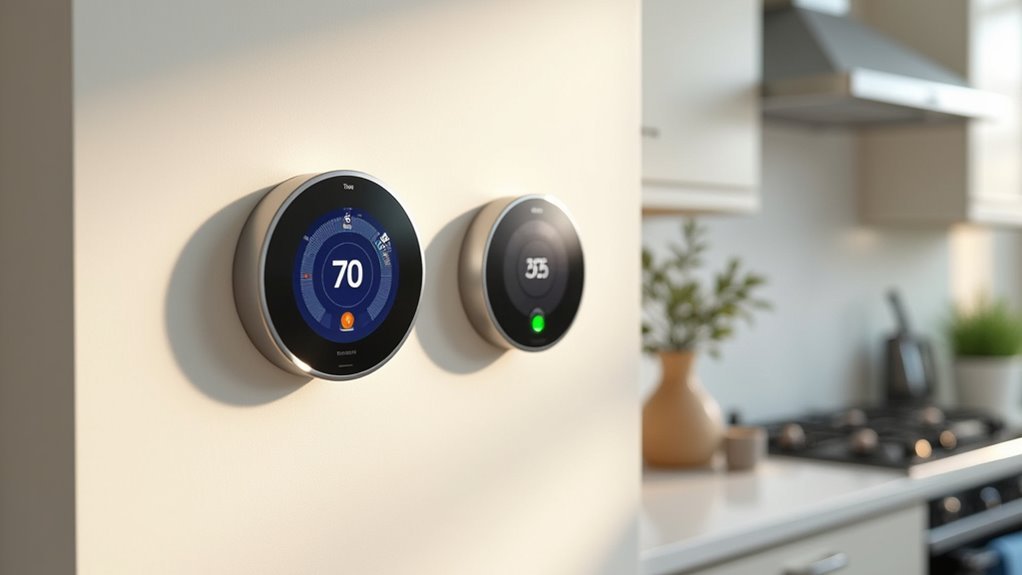
When you’re building a thorough smart home ecosystem, Ecobee’s extensive compatibility gives you the flexibility to connect with virtually any platform you’re already using.
Unlike Nest, which lacks Apple HomeKit support, the Ecobee Smart Thermostat works seamlessly with HomeKit, Google Assistant, Amazon Alexa, and IFTTT. This broad compatibility means you won’t face integration headaches when expanding your smart home setup.
The Ecobee Smart Thermostat Premium includes a built-in Alexa speaker, eliminating the need for additional devices while providing voice control throughout your home.
Combined with remote sensors that monitor multiple rooms, you’ll achieve better temperature control and energy efficiency.
The detailed 18-month energy usage history helps you optimize settings across all connected smart home platforms for maximum savings.
Energy Efficiency and Cost Savings Comparison
When you’re comparing smart thermostats, the bottom line often comes down to how much money you’ll save on your energy bills.
Ecobee users consistently report average savings of 26% on heating and cooling costs, which greatly outperforms Nest’s more modest 10%-12% heating savings and 15% cooling savings.
You’ll see these superior savings translate into substantial long-term cost benefits that can quickly offset your initial investment.
Ecobee’s Superior Savings
Anyone choosing a smart thermostat wants to see real savings on their energy bills, and this is where Ecobee clearly outperforms Nest.
While Nest users typically see 10%-12% heating savings and 15% cooling reductions, Ecobee delivers up to 23% in combined heating and cooling cost reductions.
Ecobee’s superior energy savings come from three key advantages:
- Smart scheduling during peak pricing – You can customize your HVAC usage to avoid expensive electricity hours.
- Extended usage tracking – 18-month detailed energy history versus Nest’s limited 10-day tracking helps you optimize further.
- Occupancy-based temperature management – Remote sensors detect which rooms you’re actually using, eliminating wasted energy on empty spaces.
These features combine to deliver measurable results that directly impact your monthly utility bills.
Long-Term Cost Benefits
Beyond the immediate energy savings discussed above, the financial advantages of choosing Ecobee become even more pronounced over time.
Your Ecobee Smart Thermostat’s 26% average energy savings compound annually, creating substantial long-term cost benefits that far exceed Nest’s 10%-15% savings range. The advanced energy tracking features help you identify ideal usage patterns across 18 months of detailed history, enabling smarter consumption decisions.
You’ll maximize temperature control efficiency through Ecobee’s remote sensors, which eliminate wasteful heating and cooling in unoccupied rooms.
The system’s ability to precool or preheat during lower electricity rate periods adds another layer of savings. Over several years, these combined features translate into hundreds of dollars in reduced utility bills, making Ecobee’s superior technology a smart financial investment for your home.
User Interface and Control Options
While both thermostats offer modern control methods, you’ll find significant differences in how you interact with each device.
Ecobee’s user interface provides multiple advantages that make daily operation more intuitive and efficient.
Here’s what sets Ecobee apart regarding control:
- Touchscreen convenience – You can adjust temperature settings directly on the device without relying solely on your phone, unlike Nest’s app-dependent approach.
- Unified app experience – The Ecobee app consolidates all features into one platform with detailed reporting and scheduling options, while Nest requires two separate apps for full functionality.
- Hands-free control – Built-in Alexa lets you make voice adjustments instantly, and remote sensors integrate seamlessly into the interface for room-specific temperature management.
Reliability and Long-Term Performance Considerations
When you’re investing in a smart thermostat, you’ll want to reflect on how well it’ll hold up over years of daily use.
Hardware durability becomes essential as these devices face constant temperature changes and mechanical wear from regular operation.
You’ll also need to ponder potential battery failures and connectivity issues that could leave you without climate control when you need it most.
Hardware Durability Issues
Although smart thermostats promise years of reliable operation, hardware durability varies considerably between Ecobee and Nest models. When you’re choosing between these brands, you’ll find significant differences in long-term reliability that can impact your investment.
Ecobee consistently outperforms Nest in hardware durability through several key advantages:
- Component longevity – Ecobee’s sensors and main units maintain reliable performance for multiple years without significant failures, while nest devices commonly experience battery issues within two to three years.
- Stable connectivity – You’ll experience fewer Wi-Fi connectivity problems with Ecobee’s robust design compared to Nest’s documented connection issues.
- Power management – Ecobee’s Power Extender Kit prevents battery drainage concerns that plague many Nest installations, ensuring consistent operation.
Battery Failure Concerns
Among the most problematic durability issues, battery failures represent a significant concern that directly affects your thermostat’s day-to-day performance.
Ecobee’s design prioritizes a consistent power source from your HVAC system, virtually eliminating the battery failures that plague Nest thermostats. While Nest relies on lithium-ion batteries that users report failing within two to three years, Ecobee includes a Power Extender Kit for installations lacking a C wire, ensuring stable operation without battery dependency.
You’ll avoid the connectivity problems that occur when Nest’s battery levels drop, maintaining consistent performance over time.
Ecobee customers report 26% average savings on heating and cooling costs, demonstrating how reliable power management sustains energy efficiency long-term compared to Nest’s battery-dependent approach.
Connectivity Stability Problems
Beyond battery failures, connectivity stability problems create ongoing frustration that undermines your smart thermostat’s core functionality.
Nest’s battery reliability issues directly contribute to connectivity problems, especially in systems without a C wire.
Ecobee’s 24 VAC power requirement eliminates these concerns entirely.
Here’s why Ecobee delivers superior connectivity performance:
- Stable power supply – Unlike battery-dependent models, Ecobee’s hardwired connection prevents power-related connectivity issues that plague Nest users.
- Professional installation support – Proper wiring reduces connectivity problems from improper setup that often affect DIY Nest installations.
- Consistent network communication – Reliable power means your Ecobee maintains steady Wi-Fi connections without unexpected dropouts.
You’ll experience fewer frustrating disconnections and maintain reliable smart home integration when you choose Ecobee’s proven connectivity approach over Nest’s problematic battery system.
Battery Life and Maintenance Requirements
Two distinct approaches to power management separate Ecobee and Nest thermostats, creating vastly different maintenance experiences for homeowners.
Ecobee’s design eliminates battery life concerns entirely by requiring a consistent power source through a C wire or Power Extender Kit. You’ll enjoy uninterrupted functionality without worrying about battery drain affecting your system’s performance.
Meanwhile, Nest’s lithium-ion battery creates ongoing maintenance requirements that you’ll need to actively manage. If you don’t have a C wire, you’ll face frequent recharging cycles that can disrupt your thermostat’s operation.
Ecobee users report considerably fewer maintenance needs since their thermostats operate continuously without battery interruptions. Your regular maintenance becomes limited to monitoring HVAC performance through the app, while Nest users must constantly track battery levels.
Scheduling Features and Customization Capabilities
When you need precise control over your home’s temperature scheduling, Ecobee and Nest offer fundamentally different approaches that’ll dramatically impact your daily comfort experience.
Ecobee’s scheduling features give you direct manual control over Home, Away, and Sleep modes, while Nest’s learning algorithms often struggle with irregular routines.
Ecobee delivers predictable manual scheduling control while Nest’s automated learning fails with unpredictable daily routines.
You’ll appreciate these key advantages:
- Room-specific customization capabilities – Ecobee’s remote sensors let you assign temperature preferences to individual rooms based on occupancy.
- Comprehensive energy insights – Access 18 months of usage history compared to Nest’s limited 10-day window.
- User-friendly interface – The touchscreen simplifies scheduling directly on the device versus Nest’s app-only approach.
For larger homes especially, Ecobee’s remote sensors provide tailored temperature adjustments that consider actual room occupancy, ensuring ideal comfort throughout your space.
Professional Vs DIY Installation Guidelines
While Nest markets itself as DIY-friendly, you’ll find that Ecobee’s professional installation route often delivers superior long-term performance and reliability. Though DIY installation appeals to tech-savvy homeowners, Ecobee’s complexity with HVAC systems and C wire requirements makes professional installation worthwhile.
| Installation Aspect | Ecobee Professional | Nest DIY |
|---|---|---|
| C Wire Setup | Power Extender Kit included | May require workarounds |
| HVAC Compatibility | Expert assessment guaranteed | User troubleshooting needed |
| Long-term Performance | Optimized configuration | Potential battery/connectivity issues |
You’ll benefit from Ecobee’s professional installation through proper wire configuration and compatibility verification. While both brands can challenge inexperienced users, professional installation eliminates guesswork with multiple wires and complex HVAC systems. This approach prevents battery drainage and connectivity problems that plague DIY installations.
Troubleshooting Common Installation Challenges
Even with professional guidance, installation hiccups can derail your thermostat upgrade plans. When your Ecobee encounters setup challenges, systematic troubleshooting gets you back on track quickly.
Common installation problems you’ll face include:
- Blank screen issues – Check all wire connections are secure and verify your 24 VAC supply using a multimeter before attempting a manual reset.
- C-wire complications – Install the included Power Extender Kit if your system lacks the necessary wiring for reliable operation.
- Connectivity problems – Use the Ecobee mobile app’s diagnostic features to identify and resolve network setup issues.
The mobile app becomes your troubleshooting companion, offering step-by-step guidance for resolving connection failures and configuration errors.
When wire connections seem correct but problems persist, the app’s diagnostic tools help identify underlying system compatibility issues that might require additional hardware or professional assessment.
Warranty and Customer Support Differences
When you’re investing in a smart thermostat, you’ll want to understand how each brand backs their product with warranty coverage and handles your support needs.
Ecobee offers longer warranty periods than Nest, giving you extended protection for your investment.
You’ll also find significant differences in support response times, with Ecobee typically providing faster, more accessible customer service compared to Nest’s often lengthy wait times.
Warranty Coverage Terms
Before investing in a smart thermostat, you’ll want to understand how each brand protects your purchase through warranty coverage. Ecobee’s extensive three-year warranty greatly outperforms Nest’s shorter, model-dependent coverage periods.
Here’s what sets Ecobee’s warranty apart:
- Broader defect coverage – Ecobee covers materials and workmanship defects without restrictive conditions that might limit your claims.
- Faster replacement process – You won’t be left without climate control for weeks while waiting for defective units to be processed.
- Straightforward terms – Unlike Nest’s warranty that may exclude coverage based on specific user actions or conditions.
When you need customer support, Ecobee’s responsive service contrasts sharply with Nest’s hour-long wait times.
This combination of better coverage and superior support makes Ecobee the smarter choice for protecting your investment.
Support Response Times
The quality of customer support can make or break your smart thermostat experience, especially when you’re dealing with installation issues or warranty claims.
When comparing support response times between Ecobee and Nest, you’ll find a significant difference in accessibility and efficiency.
Ecobee users consistently report quicker response times and more helpful service experiences. You’re likely to connect with a representative faster and receive the assistance you need without lengthy delays.
In contrast, Nest users often face frustrating wait times, with calls taking an hour or more to reach customer support.
Ecobee’s responsive support structure stems from their commitment to direct customer feedback, creating an engaged community.
This approach guarantees you’ll receive timely help when technical issues arise with your thermostat installation or operation.
Making the Right Choice for Your Home’s Needs
How do you determine which smart thermostat best fits your home’s unique requirements? Consider these key factors when choosing between Ecobee and Nest:
- Installation complexity – If your home lacks a C-wire, Ecobee’s Power Extender Kit eliminates the need for professional installation, saving you time and money compared to Nest’s more complex wiring requirements.
- Energy efficiency goals – With built-in occupancy sensors and reported 26% savings on heating and cooling costs, Ecobee delivers superior energy efficiency through precise room-based temperature control.
- User interface preferences – Ecobee’s intuitive touchscreen interface provides direct control without relying heavily on mobile apps, unlike Nest’s app-dependent approach.
Choose Ecobee if you want easier installation, better energy savings, and integrated smart home features like the built-in speaker.
Frequently Asked Questions
How Difficult Is It to Install an Ecobee Thermostat?
You’ll find installing an Ecobee thermostat relatively straightforward, typically taking under an hour. While it’s manageable for most homeowners, you might face challenges if you’re unfamiliar with HVAC wiring systems.
What Are the Drawbacks of a Nest Thermostat?
You’ll face multiple app requirements, unreliable temperature readings, no remote sensors on base models, limited 10-day energy history, and potential customer support delays with long wait times for assistance.
What Is a Common Problem With Nest Thermostats?
You’ll commonly experience inaccurate temperature readings with Nest thermostats, especially after installation. This leads to inefficient heating and cooling since your system can’t properly gauge your home’s actual temperature needs.
Do You Need a Professional to Install Nest Thermostat?
You don’t need a professional to install a Nest thermostat if you’re comfortable with basic wiring. However, you’ll want professional help if your home lacks a C wire or you’re unfamiliar with HVAC systems.

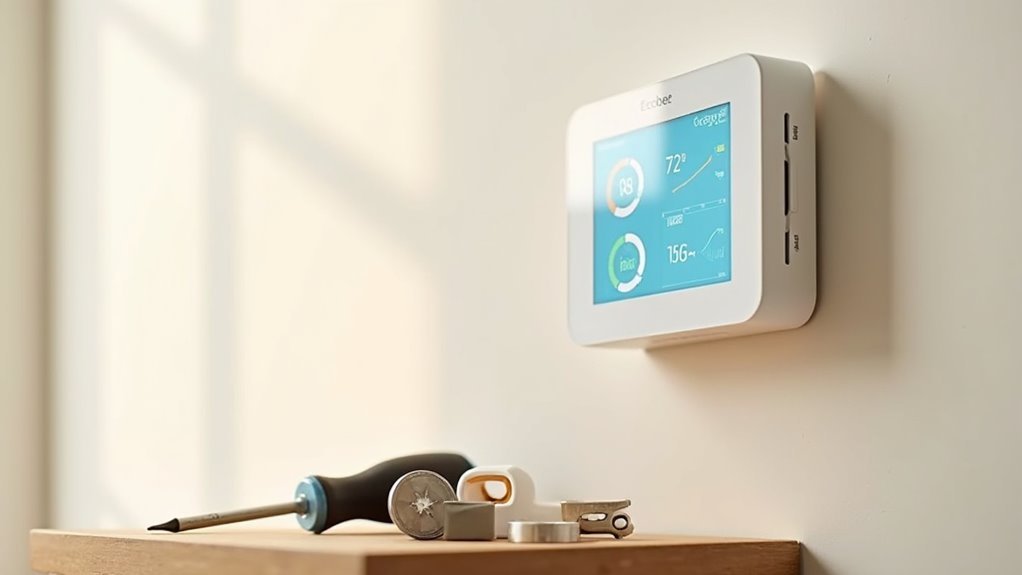
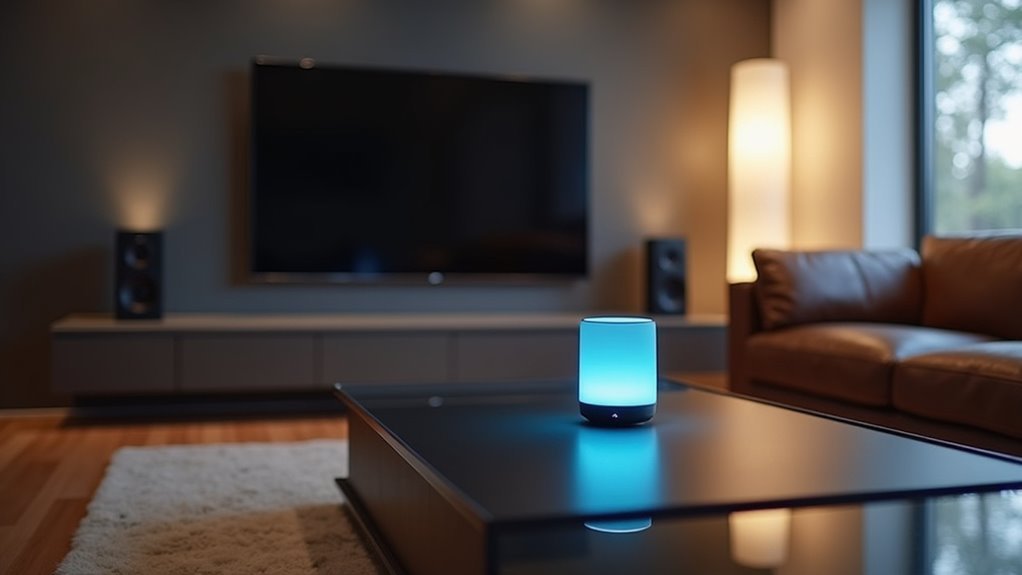

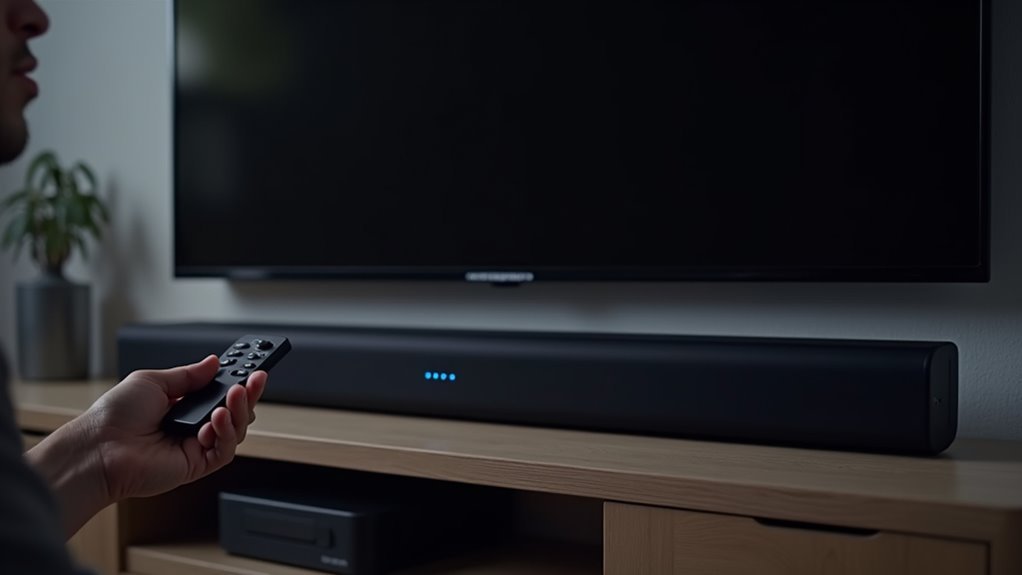
Leave a Reply